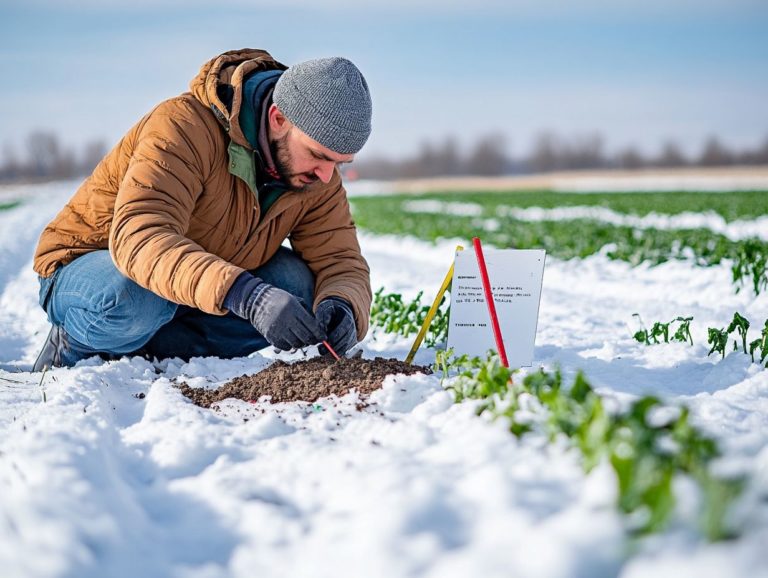How to Identify and Treat Cold Weather Diseases
As temperatures begin to plummet, the risk of cold weather diseases increases, impacting individuals of all ages.
Conditions such as hypothermia and frostbite can lead to serious repercussions if not identified and treated swiftly. This article delves into common cold weather ailments, detailing their symptoms and effective treatments.
You will also find insights on preventive measures to safeguard yourself and your loved ones, identify at-risk populations, and essential information on recognizing and addressing hypothermia and frostbite.
Staying informed and prepared this winter is key to your well-being and the health of those around you, especially vulnerable populations at risk for cold-related illnesses.
Contents
- Key Takeaways:
- What are Cold Weather Diseases?
- Common Cold Weather Diseases
- Preventing Cold Weather Diseases
- At-Risk Populations for Cold Weather Diseases
- Identifying and Addressing Hypothermia
- Recognizing and Treating Frostbite
- Frequently Asked Questions
- What are some common cold weather diseases and cold-related illnesses?
- How can I identify a cold weather disease?
- Can I prevent cold weather diseases?
- Wondering how to treat cold weather illnesses effectively?
- What should I do if I suspect hypothermia or frostbite?
- Are there any long-term effects of cold weather illnesses?
Key Takeaways:

- Dress appropriately for the weather to prevent cold weather diseases. Layer up, wear proper footwear, and cover exposed skin.
- At-risk populations, such as children and the elderly, must take extra precautions in cold weather to avoid illnesses.
- Recognize the symptoms of hypothermia and frostbite, and seek immediate treatment to prevent serious health complications.
What are Cold Weather Diseases?
Cold weather diseases pose a significant risk for outdoor workers and anyone exposed to extreme conditions. These health issues arise from being outside in the cold for a long time and can range from mild ailments like chilblains (painful, itchy swellings on the skin due to cold exposure) to severe emergencies such as hypothermia and frostbite.
It’s essential to understand how to protect yourself and recognize the symptoms of these cold-related illnesses. Taking proactive measures is vital to prevent health risks from cold weather and safeguard your safety and well-being when faced with harsh conditions.
Common Cold Weather Diseases
Several common cold weather ailments can impact you, especially if your work involves spending long periods outdoors in frigid temperatures. Among these, hypothermia and frostbite are the most urgent concerns, as they can lead to severe complications if not addressed swiftly.
Other conditions like trench foot and chilblains also present risks, particularly for vulnerable groups such as infants and older adults. Understanding the nature of these illnesses is crucial for minimizing the dangers associated with cold exposure.
Symptoms and Treatment
Spotting the symptoms quickly can save lives! Recognizing the symptoms and obtaining appropriate treatment for cold-related illnesses, such as hypothermia and frostbite, is essential for preventing serious health complications. Early signs of hypothermia may manifest as shivering and confusion, while frostbite can reveal itself through numbness and discoloration in the affected areas.
In more severe instances, seeking proper medical assistance becomes crucial. As hypothermia progresses, late symptoms may escalate to drowsiness and a weakened pulse, highlighting the pressing need for help. Similarly, as frostbite advances, it can lead to blistering and intense pain, signaling an urgent requirement for medical intervention.
To safeguard against these risks, wearing protective clothing and sipping warm beverages are vital preventive measures. Employ specific techniques to gently warm affected areas such as soaking them in warm water while avoiding direct heat. Staying well-informed enhances your safety during chilly conditions, allowing you to navigate the cold with confidence.
Preventing Cold Weather Diseases

Preventing cold-weather diseases demands a thorough understanding of health risks from cold weather and the implementation of effective preventive measures, especially for outdoor workers regularly facing harsh conditions.
It’s crucial to wear protective clothing, maintain your body temperature, and stay hydrated with warm beverages. These strategies are vital for steering clear of cold-related illnesses.
By proactively addressing the risk factors, you can significantly diminish the chances of encountering serious health issues during those chilly exposures.
Prepare for the cold weather and share these safety tips with others to ensure everyone stays safe and healthy!
Effective Preventive Measures
Implementing effective preventive measures against cold weather diseases is essential for your safety and well-being, especially if you re working outdoors in frigid conditions. Key strategies to adopt include:
- Wearing insulated protective clothing that minimizes heat loss.
- Sipping on warm beverages to keep your body temperature up.
- Remaining vigilant for early symptoms of cold stress.
These actions can significantly lower your risk of severe health issues like hypothermia and frostbite.
Layering your clothing traps warmth effectively while still allowing for adjustments as your activity levels change. Consider incorporating protective gear such as gloves, hats, and thermal socks to shield yourself from harsh winds and moisture. Always remember to maintain your body temperature.
Staying hydrated is crucial. Warm drinks not only hydrate but also help elevate your core body temperature.
Taking regular breaks in a warm environment allows you to recuperate and check for any signs of cold-related ailments.
Lastly, increasing awareness about the dangers of extreme temperatures and the importance of monitoring each other for symptoms fosters a safer work environment amidst these challenging conditions.
At-Risk Populations for Cold Weather Diseases
Certain populations are inherently more vulnerable to cold weather diseases due to various risk factors. For instance, outdoor workers, infants, and older adults are at a heightened risk for cold-related illnesses such as hypothermia, frostbite, and cold exposure.
This risk escalates further for those with chronic conditions that compromise their overall health. Understanding the unique vulnerabilities of these groups is essential for devising targeted preventive measures that effectively mitigate the dangers posed by cold exposure.
Groups Prone to Cold-Related Illnesses
Individuals who are prone to cold-related illnesses like outdoor workers, infants, and older adults must remain particularly vigilant during extreme cold spells.
The risks associated with cold exposure extend beyond mere discomfort. Without proper precautions, serious health issues such as frostbite and hypothermia can occur. Outdoor workers face ongoing threats due to prolonged hours in frigid environments, where wind chill the cooling effect of the wind that makes temperatures feel colder can amplify the effects of the cold.
Infants, with their developing body heat control systems, are especially vulnerable, as they lose body heat more rapidly. Older adults often struggle with underlying health conditions that hinder their ability to sense temperature changes, making them more susceptible to cold-related ailments.
To mitigate these risks, it’s essential to implement tailored preventive strategies.
- Layered clothing
- Accessible warming stations for outdoor workers
- Careful monitoring of infants and seniors
These strategies can significantly enhance safety and well-being throughout the colder months.
Identifying and Addressing Hypothermia

Identifying and addressing hypothermia promptly is essential for preventing serious complications and ensuring effective treatment. This cold-related illness can present itself through a range of symptoms, such as shivering, confusion, and lethargy.
When these symptoms appear, seek medical assistance immediately to avoid potentially life-threatening situations. Early recognition and intervention greatly enhance outcomes for those affected by hypothermia, making vigilance and swift action paramount.
Symptoms and Treatment
The symptoms and treatment of hypothermia are critical in managing this potentially life-threatening cold-related illness. Be on the lookout for early signs like shivering you can’t control, confusion, and drowsiness.
If left unchecked, these can escalate into more severe symptoms. It s imperative to seek immediate medical assistance. Effective treatment strategies focus on warming the individual and preventing further heat loss, highlighting the importance of quick identification.
Recognizing these signs is essential, as they can significantly influence the outcome. If you suspect hypothermia, look for signs like slurred speech, a slow heart rate, or even a lack of responsiveness. These indicate the urgent need for care.
Treatment typically starts with moving the person to a warmer environment. After that, using dry blankets or clothing helps conserve body heat. Offering warm, non-alcoholic beverages can also aid in gradually restoring core temperature.
Avoid using direct heat sources, like hot baths they can be dangerous! Understanding these methods plays a vital role in stabilizing someone while waiting for professional medical support.
Recognizing and Treating Frostbite
Recognizing and addressing frostbite promptly is crucial to safeguard against permanent damage, especially for high-risk groups such as infants and older adults.
You might notice early symptoms like numbness and tingling, which can swiftly progress to alarming signs, such as discoloration and blisters. Understanding these symptoms is vital for effective treatment.
In severe frostbite cases, you should seek immediate medical assistance to ensure you receive the appropriate treatment and care needed for healing.
Recognizing the symptoms of frostbite and initiating treatment promptly is essential for avoiding severe complications and preserving tissue integrity. Symptoms may include numbness, tingling, and discoloration, all of which can escalate rapidly if not addressed.
In the early stages, the affected areas might appear pale or red, and the skin will feel cold and hard to the touch. As frostbite progresses, you may see blisters forming, and the skin could take on a grayish or black hue, which indicates tissue death.
Timely intervention can significantly reduce the risk of these alarming symptoms. Treatment typically involves gradually rewarming the affected areas using body heat or warm water just be sure not to rub the skin, as that can make things worse.
In more severe cases of frostbite, professional medical care might include advanced therapies, pain management, and sometimes even surgical intervention. Ensuring proper aftercare is vital for enhancing recovery and helping to prevent future occurrences.
Frequently Asked Questions

Some common cold weather diseases include the common cold, influenza (flu), bronchitis, pneumonia, hypothermia, and frostbite.
How can I identify a cold weather disease?
Symptoms of cold weather diseases can vary, but common signs include fever, chills, body aches, congestion, coughing, and difficulty breathing. If you are experiencing any of these symptoms, it s important to seek medical attention.
Can I prevent cold weather diseases?
Yes, you can prevent cold weather diseases by taking necessary precautions such as washing your hands regularly, avoiding contact with sick individuals, and dressing warmly when going outside in cold weather.
Wondering how to treat cold weather illnesses effectively?
The best way to treat a cold weather disease is to rest, stay hydrated, and take over-the-counter medications to relieve symptoms. It s also important to seek medical attention if symptoms persist or worsen.
What should I do if I suspect hypothermia or frostbite?
If you suspect hypothermia, get to a warm place and remove any wet clothing. Wrap yourself in blankets and drink warm fluids. If you suspect frostbite, warm the affected area with warm water (not hot) and seek medical attention immediately.
Are there any long-term effects of cold weather illnesses?
Cold weather can be tough on our bodies. Have you ever wondered about the dangers of cold-related illnesses?
These illnesses can lead to serious complications, like respiratory infections or damage to the skin from frostbite. Treating them properly can help prevent long-term problems.






